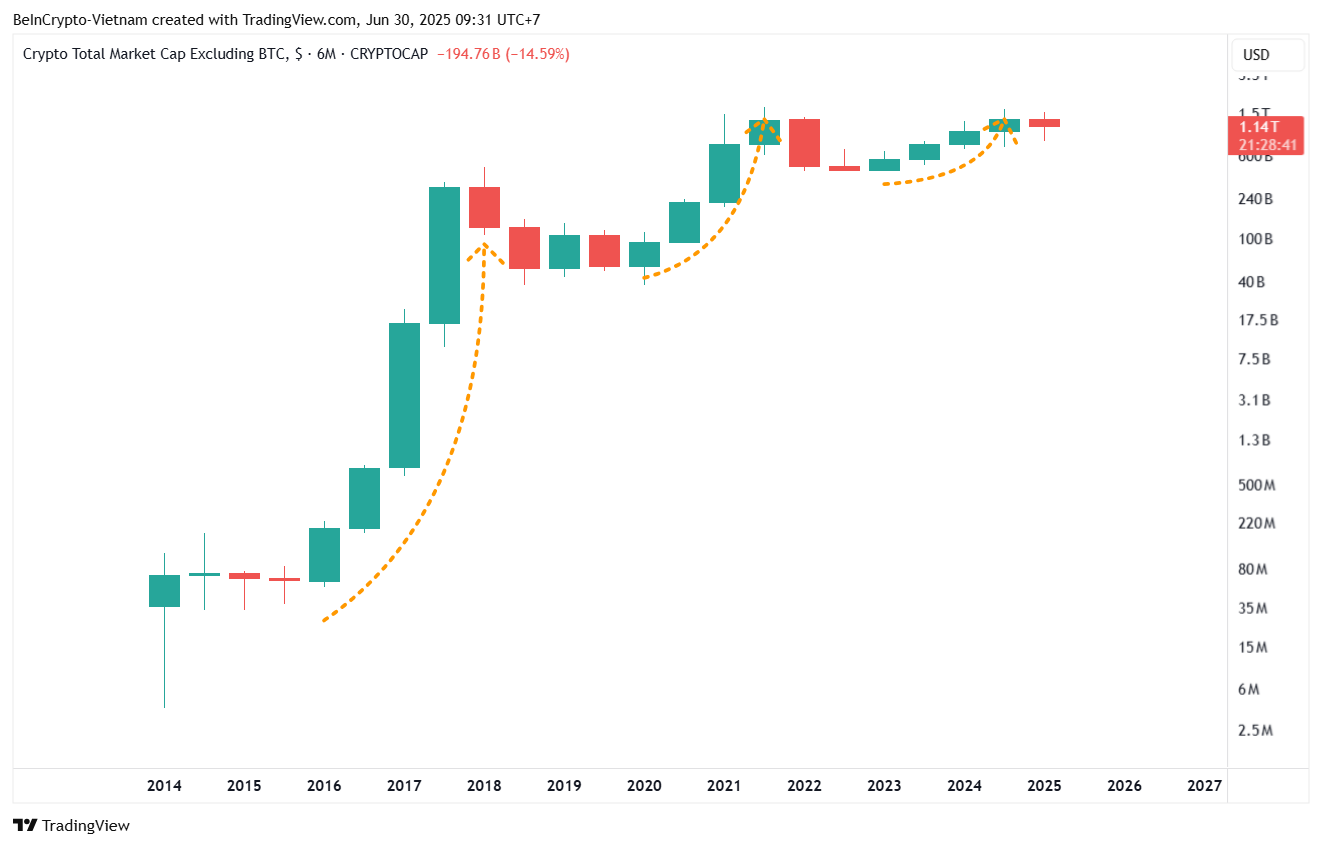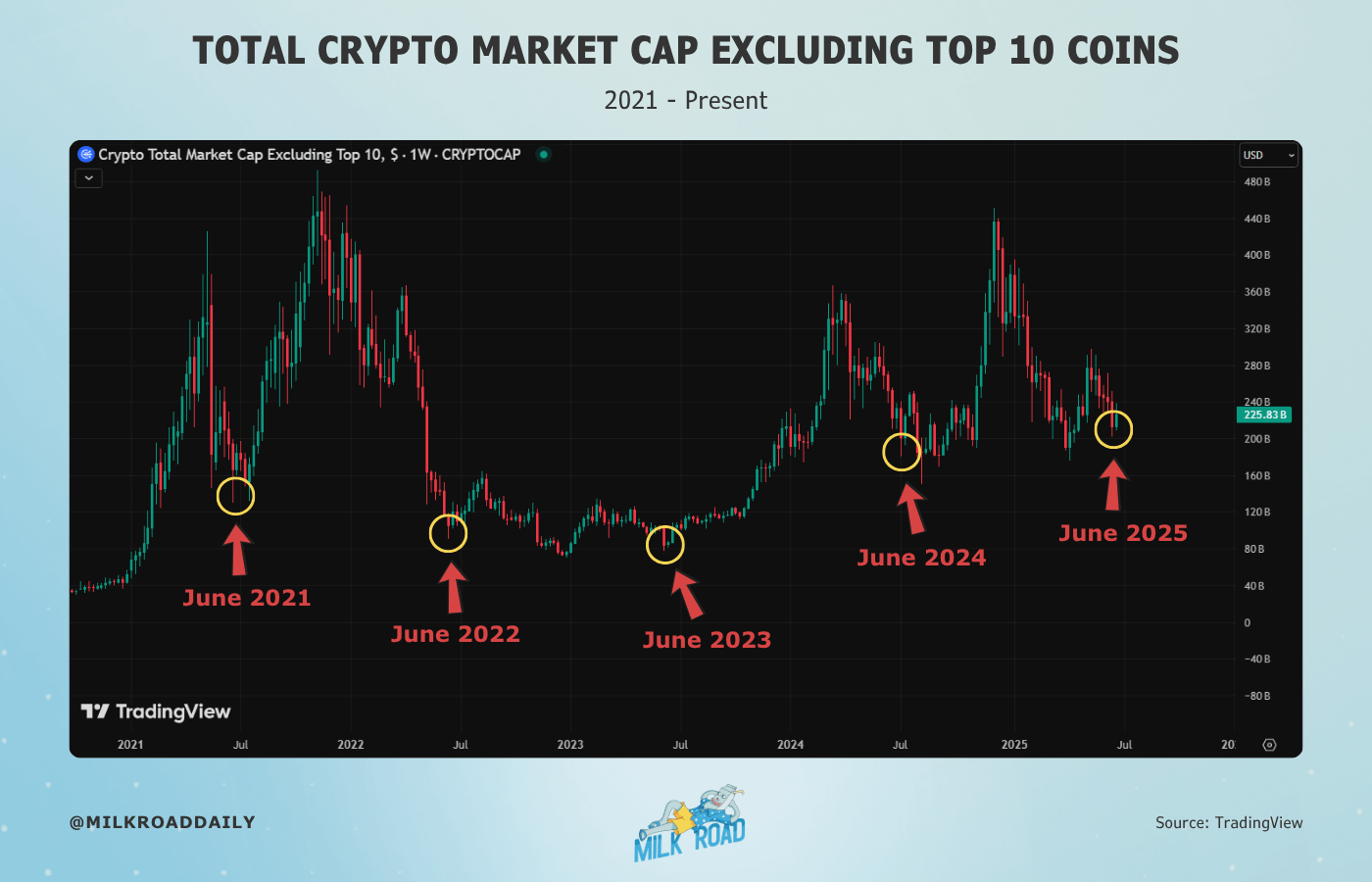| COINOTAG recommends • Exchange signup |
| 💹 Trade with pro tools |
| Fast execution, robust charts, clean risk controls. |
| 👉 Open account → |
| COINOTAG recommends • Exchange signup |
| 🚀 Smooth orders, clear control |
| Advanced order types and market depth in one view. |
| 👉 Create account → |
| COINOTAG recommends • Exchange signup |
| 📈 Clarity in volatile markets |
| Plan entries & exits, manage positions with discipline. |
| 👉 Sign up → |
| COINOTAG recommends • Exchange signup |
| ⚡ Speed, depth, reliability |
| Execute confidently when timing matters. |
| 👉 Open account → |
| COINOTAG recommends • Exchange signup |
| 🧭 A focused workflow for traders |
| Alerts, watchlists, and a repeatable process. |
| 👉 Get started → |
| COINOTAG recommends • Exchange signup |
| ✅ Data‑driven decisions |
| Focus on process—not noise. |
| 👉 Sign up → |
-
Experts urge altcoin traders to adopt disciplined trading strategies amid persistent high Bitcoin Dominance, signaling a challenging market environment.
-
The “Low-IQ Altcoin Strategy” recommends buying strong altcoins at oversold levels, adding on dips, and exiting at moderate profits to mitigate risk.
-
Mixed market signals suggest a prolonged altcoin winter, though historical data points to June as a potential turning point for recovery.
Altcoin traders face a tough market with rising Bitcoin Dominance; disciplined trading strategies and June’s historical trends offer cautious hope for recovery.
Why Shifting From Buy-and-Hold to Disciplined Trading
With altcoin traders experiencing widespread losses, a shift from the traditional buy-and-hold approach is increasingly recommended. Stockmoney Lizards, a respected investor on X, introduced the “Low-IQ Altcoin Strategy” to help traders navigate volatile markets with a structured plan. This strategy focuses on selecting reputable altcoins, such as SOL, ADA, and ETH, which have demonstrated resilience across multiple market cycles, thereby reducing exposure to high-risk projects.
Capital allocation is another critical component, with the strategy advising division of funds into five equal parts to enable staggered buying at strategic points. Entry points are defined by technical indicators, specifically entering positions when the daily Relative Strength Index (RSI) falls below 30, signaling oversold conditions. Additional purchases are made after each subsequent 10% price decline, allowing for cost averaging.
Exit strategies are equally disciplined, recommending full liquidation when profits reach between 30% and 50%. This approach aims to protect gains in a market known for sudden volatility and manipulation by large holders. Stockmoney Lizards emphasizes that while this method does not promise rapid wealth accumulation, it significantly reduces the risk of total capital loss, a common pitfall for many altcoin investors.
| COINOTAG recommends • Professional traders group |
| 💎 Join a professional trading community |
| Work with senior traders, research‑backed setups, and risk‑first frameworks. |
| 👉 Join the group → |
| COINOTAG recommends • Professional traders group |
| 📊 Transparent performance, real process |
| Spot strategies with documented months of triple‑digit runs during strong trends; futures plans use defined R:R and sizing. |
| 👉 Get access → |
| COINOTAG recommends • Professional traders group |
| 🧭 Research → Plan → Execute |
| Daily levels, watchlists, and post‑trade reviews to build consistency. |
| 👉 Join now → |
| COINOTAG recommends • Professional traders group |
| 🛡️ Risk comes first |
| Sizing methods, invalidation rules, and R‑multiples baked into every plan. |
| 👉 Start today → |
| COINOTAG recommends • Professional traders group |
| 🧠 Learn the “why” behind each trade |
| Live breakdowns, playbooks, and framework‑first education. |
| 👉 Join the group → |
| COINOTAG recommends • Professional traders group |
| 🚀 Insider • APEX • INNER CIRCLE |
| Choose the depth you need—tools, coaching, and member rooms. |
| 👉 Explore tiers → |
“You won’t get rich quick. But you also won’t lose everything like 99% of altcoin traders do…This boring strategy is exactly how I survived my early trading days,” Stockmoney Lizards remarked, underscoring the value of patience and risk management.
Michaël van de Poppe, CIO and founder of MNFund, supports this cautious approach, highlighting the dangers of buying into altcoins only after significant price increases, which often leads to losses. The disciplined trading framework helps mitigate the fear of missing out (FOMO) and encourages a more measured investment mindset.
| COINOTAG recommends • Exchange signup |
| 📈 Clear interface, precise orders |
| Sharp entries & exits with actionable alerts. |
| 👉 Create free account → |
| COINOTAG recommends • Exchange signup |
| 🧠 Smarter tools. Better decisions. |
| Depth analytics and risk features in one view. |
| 👉 Sign up → |
| COINOTAG recommends • Exchange signup |
| 🎯 Take control of entries & exits |
| Set alerts, define stops, execute consistently. |
| 👉 Open account → |
| COINOTAG recommends • Exchange signup |
| 🛠️ From idea to execution |
| Turn setups into plans with practical order types. |
| 👉 Join now → |
| COINOTAG recommends • Exchange signup |
| 📋 Trade your plan |
| Watchlists and routing that support focus. |
| 👉 Get started → |
| COINOTAG recommends • Exchange signup |
| 📊 Precision without the noise |
| Data‑first workflows for active traders. |
| 👉 Sign up → |
Despite its merits, maintaining such discipline remains challenging, as many traders continue to seek rapid and substantial profits. As one investor on X noted, “Not the strategy most people in crypto believe in, but need to. They want that Lambo yesterday.” This sentiment reflects the broader tension between realistic trading practices and speculative desires within the crypto community.
Will Altcoin Season Arrive in H2 2025?
Market analysis presents a mixed outlook for altcoins in the second half of 2025. A recent COINOTAG report highlights that the altcoin market capitalization excluding Bitcoin (TOTAL2) has completed four consecutive green six-month candles and appears to be entering a red candle phase, traditionally signaling potential downturns.
| COINOTAG recommends • Traders club |
| ⚡ Futures with discipline |
| Defined R:R, pre‑set invalidation, execution checklists. |
| 👉 Join the club → |
| COINOTAG recommends • Traders club |
| 🎯 Spot strategies that compound |
| Momentum & accumulation frameworks managed with clear risk. |
| 👉 Get access → |
| COINOTAG recommends • Traders club |
| 🏛️ APEX tier for serious traders |
| Deep dives, analyst Q&A, and accountability sprints. |
| 👉 Explore APEX → |
| COINOTAG recommends • Traders club |
| 📈 Real‑time market structure |
| Key levels, liquidity zones, and actionable context. |
| 👉 Join now → |
| COINOTAG recommends • Traders club |
| 🔔 Smart alerts, not noise |
| Context‑rich notifications tied to plans and risk—never hype. |
| 👉 Get access → |
| COINOTAG recommends • Traders club |
| 🤝 Peer review & coaching |
| Hands‑on feedback that sharpens execution and risk control. |
| 👉 Join the club → |

Historically, such patterns have been followed by two red candles, suggesting that altcoins may face continued pressure in H2 2025. However, alternative perspectives offer cautious optimism. Investor Milk Road points out that since 2021, June has consistently marked a pivotal turning point for altcoins excluding the top 10 cryptocurrencies, often signaling market bottoms and subsequent recoveries.

“Every June since 2021 has marked a key turning point in the altcoin market… And June 2025 could be following the same script,” Milk Road observed, suggesting that despite current bearish signals, a recovery phase may be imminent.
| COINOTAG recommends • Exchange signup |
| 📈 Clear control for futures |
| Sizing, stops, and scenario planning tools. |
| 👉 Open futures account → |
| COINOTAG recommends • Exchange signup |
| 🧩 Structure your futures trades |
| Define entries & exits with advanced orders. |
| 👉 Sign up → |
| COINOTAG recommends • Exchange signup |
| 🛡️ Control volatility |
| Automate alerts and manage positions with discipline. |
| 👉 Get started → |
| COINOTAG recommends • Exchange signup |
| ⚙️ Execution you can rely on |
| Fast routing and meaningful depth insights. |
| 👉 Create account → |
| COINOTAG recommends • Exchange signup |
| 📒 Plan. Execute. Review. |
| Frameworks for consistent decision‑making. |
| 👉 Join now → |
| COINOTAG recommends • Exchange signup |
| 🧩 Choose clarity over complexity |
| Actionable, pro‑grade tools—no fluff. |
| 👉 Open account → |
Nevertheless, the prevailing high Bitcoin Dominance (BTC.D) above 65%—the highest since February 2021—remains a significant barrier to altcoin resurgence. Historically, a decline in BTC.D is necessary to trigger a robust altcoin season, and current levels indicate sustained investor preference for Bitcoin over alternative cryptocurrencies.
Investor sentiment remains divided, with some adjusting strategies to manage expectations and minimize losses, while others continue to hold out for substantial returns after prolonged periods of stagnation. This divergence underscores the complexity and uncertainty inherent in the current crypto market landscape.
| COINOTAG recommends • Members‑only research |
| 📌 Curated setups, clearly explained |
| Entry, invalidation, targets, and R:R defined before execution. |
| 👉 Get access → |
| COINOTAG recommends • Members‑only research |
| 🧠 Data‑led decision making |
| Technical + flow + context synthesized into actionable plans. |
| 👉 Join now → |
| COINOTAG recommends • Members‑only research |
| 🧱 Consistency over hype |
| Repeatable rules, realistic expectations, and a calmer mindset. |
| 👉 Get access → |
| COINOTAG recommends • Members‑only research |
| 🕒 Patience is an edge |
| Wait for confirmation and manage risk with checklists. |
| 👉 Join now → |
| COINOTAG recommends • Members‑only research |
| 💼 Professional mentorship |
| Guidance from seasoned traders and structured feedback loops. |
| 👉 Get access → |
| COINOTAG recommends • Members‑only research |
| 🧮 Track • Review • Improve |
| Documented PnL tracking and post‑mortems to accelerate learning. |
| 👉 Join now → |
Conclusion
As altcoin markets navigate a challenging environment marked by elevated Bitcoin Dominance and mixed technical signals, adopting disciplined trading strategies like the “Low-IQ Altcoin Strategy” can help mitigate risks and preserve capital. While historical trends offer hope for a market turnaround around June 2025, traders should remain cautious and avoid speculative behaviors. Maintaining realistic expectations and employing structured approaches will be essential for navigating the evolving crypto landscape in the months ahead.
| COINOTAG recommends • Members‑only research |
| 📌 Curated setups, clearly explained |
| Entry, invalidation, targets, and R:R defined before execution. |
| 👉 Get access → |
| COINOTAG recommends • Members‑only research |
| 🧠 Data‑led decision making |
| Technical + flow + context synthesized into actionable plans. |
| 👉 Join now → |
| COINOTAG recommends • Members‑only research |
| 🧱 Consistency over hype |
| Repeatable rules, realistic expectations, and a calmer mindset. |
| 👉 Get access → |
| COINOTAG recommends • Members‑only research |
| 🕒 Patience is an edge |
| Wait for confirmation and manage risk with checklists. |
| 👉 Join now → |
| COINOTAG recommends • Members‑only research |
| 💼 Professional mentorship |
| Guidance from seasoned traders and structured feedback loops. |
| 👉 Get access → |
| COINOTAG recommends • Members‑only research |
| 🧮 Track • Review • Improve |
| Documented PnL tracking and post‑mortems to accelerate learning. |
| 👉 Join now → |









